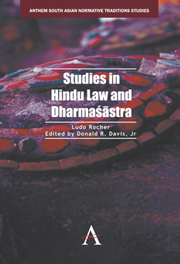Book contents
- Frontmatter
- Contents
- Foreword by Richard W. Lariviere
- Preface
- Abbreviations
- Note on the Edition
- Introduction
- PART ONE THE NATURE OF HINDU LAW
- PART TWO GENERAL TOPICS OF HINDU LAW
- Ancient Hindu Criminal Law
- Hindu Law of Succession: From the Śāstras to Modern Law
- Caste and Occupation in Classical India: The Normative Texts
- Megasthenes on Indian Lawbooks
- The “Ambassador” in Ancient India
- The Status of Minors according to Classical Hindu Law
- Quandoque bonus dormitat Jīmūtavūhanas?
- Notes on Mixed Castes in Classical India
- Inheritance and Srāddha: The Principle of “Spiritual Benefit”
- The Theory of Matrimonial Causes According to the Dharmaśāstra
- Jīmūtavūhana's Dāyabhāga and the Maxim Factum Valet
- The Divinity of Royal Power in Ancient India according to Dharmaśāstra
- A Few Considerations on Monocracy in Ancient India
- PART THREE HINDU LEGAL PROCEDURE
- PART FOUR TECHNICAL STUDIES OF HINDU LAW
- PART FIVE ANGLO-HINDU AND CUSTOMARY LAW
- Bibliography
- Index
The “Ambassador” in Ancient India
from PART TWO - GENERAL TOPICS OF HINDU LAW
Published online by Cambridge University Press: 05 February 2013
- Frontmatter
- Contents
- Foreword by Richard W. Lariviere
- Preface
- Abbreviations
- Note on the Edition
- Introduction
- PART ONE THE NATURE OF HINDU LAW
- PART TWO GENERAL TOPICS OF HINDU LAW
- Ancient Hindu Criminal Law
- Hindu Law of Succession: From the Śāstras to Modern Law
- Caste and Occupation in Classical India: The Normative Texts
- Megasthenes on Indian Lawbooks
- The “Ambassador” in Ancient India
- The Status of Minors according to Classical Hindu Law
- Quandoque bonus dormitat Jīmūtavūhanas?
- Notes on Mixed Castes in Classical India
- Inheritance and Srāddha: The Principle of “Spiritual Benefit”
- The Theory of Matrimonial Causes According to the Dharmaśāstra
- Jīmūtavūhana's Dāyabhāga and the Maxim Factum Valet
- The Divinity of Royal Power in Ancient India according to Dharmaśāstra
- A Few Considerations on Monocracy in Ancient India
- PART THREE HINDU LEGAL PROCEDURE
- PART FOUR TECHNICAL STUDIES OF HINDU LAW
- PART FIVE ANGLO-HINDU AND CUSTOMARY LAW
- Bibliography
- Index
Summary
Introduction
In Brussels the author of the present paper often visits a building, at the gate of which, in beautiful Devanāgarī characters, the words “Bhāratīya Dūtavāsa” have been inscribed on a copperplate. It is, literally translated, the “Residence of the Indian Dūta,” i.e., the “Ambassador,” as can be derived from the English words added below: “Embassy of India.” The well-known fact that the word dūta has been selected as the modern Hindi equivalent for the English Ambassador needs no further comment, but, since the word ultimately belongs to Sanskrit vocabulary, it may be asked whether the dūta in ancient India was in any way the forerunner of the present-day Indian ambassador.
Of course, diplomacy and the diplomatic agents, one of whom is the present Ambassador for India in Belgium, are quite modern institutions. “…The word [sc. diplomacy] was first used in England as late as 1796 by Burke. The need for such a term was, indeed, only then beginning to be felt; for, though in a sense as old as history, it was only in quite modern times, even in Europe, that diplomacy developed into a uniform system, based upon generally recognized rules and directed by a diplomatic hierarchy having a fixed international status” (Encyclopedia Britannica 7, 1947: 404). Nevertheless, in the following pages a brief attempt will be made to collect and to interpret a number of references to the ancient dūta, in order to show that the practice of the king's sending an envoy to another monarch was definitely not unknown in ancient times.
- Type
- Chapter
- Information
- Studies in Hindu Law and Dharmasastra , pp. 219 - 234Publisher: Anthem PressPrint publication year: 2012



